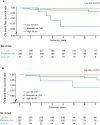Development and Validation of a Risk Score Model for Predicting the Cardiovascular Outcomes After Breast Cancer Therapy: The CHEMO-RADIAT Score
- PMID: 34369199
- PMCID: PMC8475066
- DOI: 10.1161/JAHA.121.021931
Development and Validation of a Risk Score Model for Predicting the Cardiovascular Outcomes After Breast Cancer Therapy: The CHEMO-RADIAT Score
Abstract
Background Cardiovascular disease is an important cause of mortality among survivors of breast cancer (BC). We developed a prediction model for major adverse cardiovascular events after BC therapy, which is based on conventional and BC treatment-related cardiovascular risk factors. Methods and Results The cohort of the study consisted of 1256 Asian female patients with BC from 4 medical centers in Korea and was randomized in a 1:1 ratio into the derivation and validation cohorts. The outcome measures comprised cardiovascular mortality, myocardial infarction, congestive heart failure, and transient ischemic attack/stroke. To correct overfitting, a penalized Cox proportional hazards regression was performed with a cross-validation approach. Number of cardiovascular diseases (myocardial infarction, peripheral artery disease, heart failure, and transient ischemic attack/stroke), number of baseline cardiovascular risk factors (hypertension, age ≥60, body mass index ≥30 kg/m2, estimated glomerular filtration rate <60 mL/min per 1.73 m2, dyslipidemia, and diabetes mellitus), radiation to the left breast, and anthracycline dose per 100 mg/m2 were included in the risk prediction model. The time-dependent C-indices at 3 and 7 years after BC diagnosis were 0.876 and 0.842, respectively, in the validation cohort. Conclusions A prediction score model, including BC treatment-related risk factors and conventional risk factors, was developed and validated to predict major adverse cardiovascular events in patients with BC. The CHEMO-RADIAT (congestive heart failure, hypertension, elderly, myocardial infarction/peripheral artery occlusive disease, obesity, renal failure, abnormal lipid profile, diabetes mellitus, irradiation of the left breast, anthracycline dose, and transient ischemic attack/stroke) score may provide overall cardiovascular risk stratification in survivors of BC and can assist physicians in multidisciplinary decision-making regarding the BC treatment.
Keywords: breast cancer; major adverse cardiovascular events; multicenter cohort; prediction model; risk stratification.
Conflict of interest statement
None.
Figures

References
Publication types
MeSH terms
Substances
LinkOut - more resources
Full Text Sources
Medical

